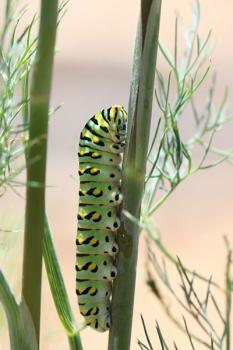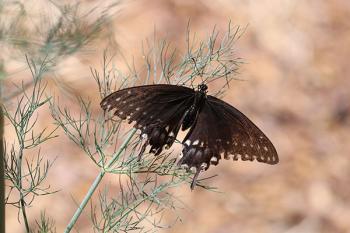August 17, 2019
Pollinator or Pest? When To Draw the Line With the Lepidoptera Order (Moths and Butterflies)
Guest columnist this week: Alissa Freeman - Senior Program Specialist and Director of the pollinator-friendly NMSU Learning Garden at the NMSU Agricultural Science Center at Los Lunas.
Question:
How do you draw the line between pest and pollinator in regards to moths and butterflies?
- Anthony S., Ruidoso
Answer:
That is an excellent question, and the answer really depends on the situation, your point of view, and several other factors. Lepidoptera is a large order of insects that includes both butterflies and moths, many of which gardeners enjoy watching flutter around in the home garden. Adult moths and butterflies are harmless to plants and use their siphoning proboscis (long mouthpart that is used like a drinking straw) to feed on nectar and pollinate the flowers they visit. However, the caterpillars (the larval [immature] stage of moths and butterflies) use their chewing mouthparts to consume plant matter and can defoliate whole plants. So how do you decide whether the caterpillar is a pest or a pollinator?
An invertebrate pest can be defined as an organism that causes damage or interference to desirable plants in the home garden, farm, or landscape. But how much damage is too much? Monarch caterpillars, for example, consume a large amount of plant material, yet gardeners rejoice when they discover monarch caterpillars in the garden. Those same gardeners recoil at the sight of a tomato hornworm, which is largely considered a pest. The tomato hornworm will eventually metamorphose into a hawkmoth (also called a sphinx moth), which provides valuable pollination services to native flowers such as sacred datura (Datura wrightii) and is a joy to watch at dusk when they are most active. Another great example of a pollinator that might be considered a pest until it has reached adulthood is the black swallowtail (Papilio polyxenes). These are voracious eaters when in the caterpillar stage and can mow down plants in the Apiaceae family (dill, parsley, fennel, carrots, etc.), while the adult butterfly is a fan favorite. Drawing a line between pest and pollinator is difficult, and the answer is never black and white.

Typically, we would consider something a pest if it crosses the economic threshold—the point at which damage is severe enough that a control treatment is required to manage pest densities to maintain economic return. This is where you, as a gardener or farmer, need to decide what amount of damage you are willing to allow for these pollinator lifecycles to be completed. It all really depends on your perspective and preferences. To create a garden that’s a true pollinator habitat, we suggest planting more than you need so you can spare some plants for our pollinators, even the not-so-popular ones. Plant extra dill and parsley so that the swallowtail caterpillars can share these herbs with you. If you love watching hawkmoths saunter around in the moonlight, consider covering most of your tomatoes with a row cover to exclude caterpillars, while leaving a few plants exposed just for the caterpillars to feed on. (Note: Row covers may also protect tomato plants from getting the beet curly top virus, especially early in the season. For more info, visit Desert Blooms and search for the very scientific term “curly.”)
If damage is severe and action is required, use strategies outlined in the NMSU Extension Circular 655: Integrated Pest Management (IPM) for Home Gardeners, to manage pest populations. Keep in mind that broad-spectrum pesticides are extremely harmful to pollinators and beneficial insects and should be used as a last resort. Even certified organic pesticides can still harm beneficial insects and should also be used with caution.
Want to double check to see if an insect has potential to be one of the good guys? The new NMSU Extension Guide H-172: Backyard Beneficial Insects in New Mexico, is a great tool with huge, beautiful photos of our local insect heroes.

Marisa Y. Thompson, PhD, is the Extension Horticulture Specialist, in the Department of Extension Plant Sciences at the New Mexico State University Los Lunas Agricultural Science Center, email: desertblooms@nmsu.edu, office: 505-865-7340, ext. 113.
Links:
For more gardening information, visit the NMSU Extension Horticulture page at Desert Blooms and the NMSU Horticulture Publications page.
Send gardening questions to Southwest Yard and Garden - Attn: Dr. Marisa Thompson at desertblooms@nmsu.edu, or at the Desert Blooms Facebook page.
Please copy your County Extension Agent and indicate your county of residence when you submit your question!